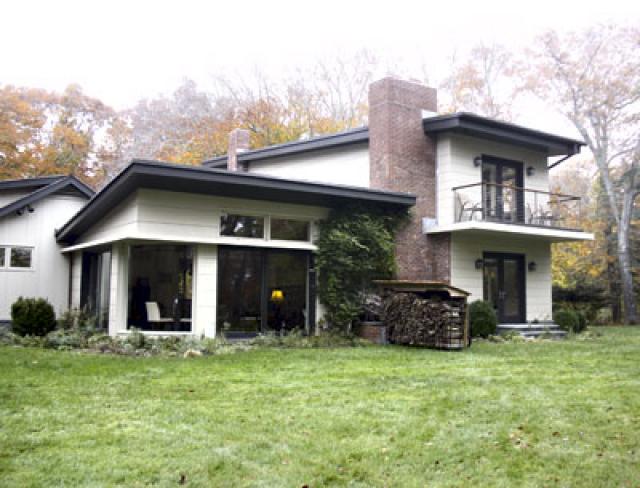Respectful Renovation of a 1950s Classic

When Robert and Jeanette Schwagerl purchased the house on Quail Hill in Amagansett in 1989, it had been for the most part abandoned. “I was going to tear it down,” Mr. Schwagerl said during a recent tour. Within a year, he had designed a new house and hired Ed Hollander, a landscape architect, to plan the grounds. But the Schwagerls soon fell in love with the existing house and abandoned the idea of demolishing it. Over the years they made a few cosmetic changes, but by 2010, with two teenaged children. Mr. Schwagerl, a designer for 40 years who had just completed a LEED-certified home in Amagansett, decided it was time for major renovation. Alfred Scheffer, who was called “the dean of East Hampton architects” in a 1970s exhibition at Guild Hall, had designed the house in the early 1950s for Samuel Rubin, the founder of Faberge cosmetics. Scheffer had created what Mr. Schwagerl called “a true classic, a genuine ‘modern’ house with Frank Lloyd Wright influences.” “When we decided to renovate, I wanted to respect Scheffer’s originality while adding energy efficiency and enhanced space for the family,” he said. “I maintained the entire vernacular. The house is like a timepiece. I thought it was important to preserve it.” Mr. Schwagerl left the living room and dining room, the core of the house, unchanged. Everything else was gutted, the wiring and plumbing were replaced, and state-of-the-art technology was used wherever possible. The house has geothermal heating and cooling, 40 solar panels on the roof -— the maximum allowed by the Long Island Power Authority —- the highest quality foam insulation, and 13 thermostats which can be controlled from anywhere in the world by iPhone. However, most of the technological improvements aren’t visible; even the solar panels can’t be seen from the ground. One original feature of the living room is a curved, floor-to-ceiling corner window that affords a dramatic view of the property. It is flanked by what in the 1950s were innovative glass doors that slide into pockets. A large brick fireplace, the original, radiant-heated bluestone floor, and heavy cedar beams, another Scheffer signature, were also retained. The living room is different from the original in one respect. The house was built around an old beech tree. To maintain it, an irrigation system had been installed beneath the floor and holes drilled into the stone so fertilizer could be supplied to its roots. Mr. Rubin died in the 1960s and eventually, apparently because the house was overheated, the beech died. A concrete-filled hole 30 inches in diameter lies beneath the living room rug. The renovated house has three levels. The first consists of Mr. Schwagerl’s office, a conference room, a mud room, and the building’s mechanicals. A floating staircase, a hallmark of 1950s modernist architecture, leads to the second floor. It is constructed from 3/4-inch plate steel clad in wood. When Mr. Schwagerl decided to add a third floor, he replicated it from the second floor up so that it’s impossible to tell the new section from the old. The exterior of the original house was clad in 15-inch-wide cedar shiplap siding. He was unable to get boards of that size for the renovation, but came close to replicating the siding with 12-inch-wide boards. Wherever Scheffer used tongue-in-groove cedar wall paneling inside the house, Mr. Schwagerl extended it to meet the new ceiling heights. The main floor of the original house consisted of the living room and dining room, which were flanked on one side by a kitchen, breakfast room, and guest bedroom, and on the other by a master bedroom. The renovation raised the ceiling heights of the two wings, extended the master bedroom 6 feet, and doubled the size of the kitchen by cantilevering it 10 feet over the front entrance. The new third floor consists of a multipurpose room and a bedroom with a balcony overlooking the rolling acreage, long fairways, and mature specimen trees. “The house’s placement to the sun is perfect Feng Shui,” Mr. Schwagerl said, “and it takes full advantage of the light and the vistas.” Mr. Schwagerl started his career in 1973 as a kitchen designer. “After 42 years, I’m really good at it,” he said with a smile. “I also happen to love to cook.” He supplied the kitchen with an enormous counter of Calcutta Gold marble for rolling out dough, and the marble’s motif has been used on custom-cut tiles in the kitchen and breakfast room. The breakfast room still has the original brick floor and a 1950s wooden door with a leaded, blown-glass window that leads to a pantry. Even the door’s hardware is original. One of the most dramatic features of the site is a European copper beech that was planted in the 1950s. The property contains other beech trees, white oak, red oak, black oak, and what a landscaper has said is the largest American holly in East Hampton. An elliptical pool, bluestone wall, evergreen hedges, and ivy-covered steps were added to the grounds in 1991. Mr. Schwagerl explained that because the property is like a bowl, neither a square pool nor a circular one would have worked. Below the pool is a garden, which is also elliptical. The Schwagerls have been members of the adjacent Quail Hill Farm for 25 years, and Mrs. Schwagerl grows plants from seed in a heated garden room inside the house before transferring them outdoors. Mr. Schwagerl first came to the South Fork after his grandfather retired and built a house on Fort Pond Boulevard in Springs. His father constructed a house on adjoining property shortly thereafter. ”We came out here every summer, all summer, from 1952, the year I was born,” Mr. Schwagerl said. Later, after the family houses were sold, he became a summer renter. “I came back here because of my childhood. I met my wife here. I was renting, she was renting, and the rest is history.”
